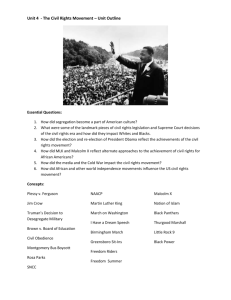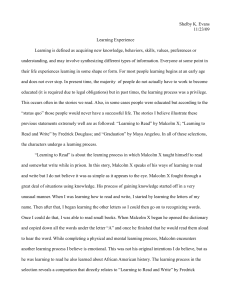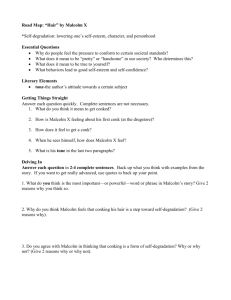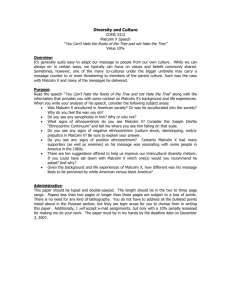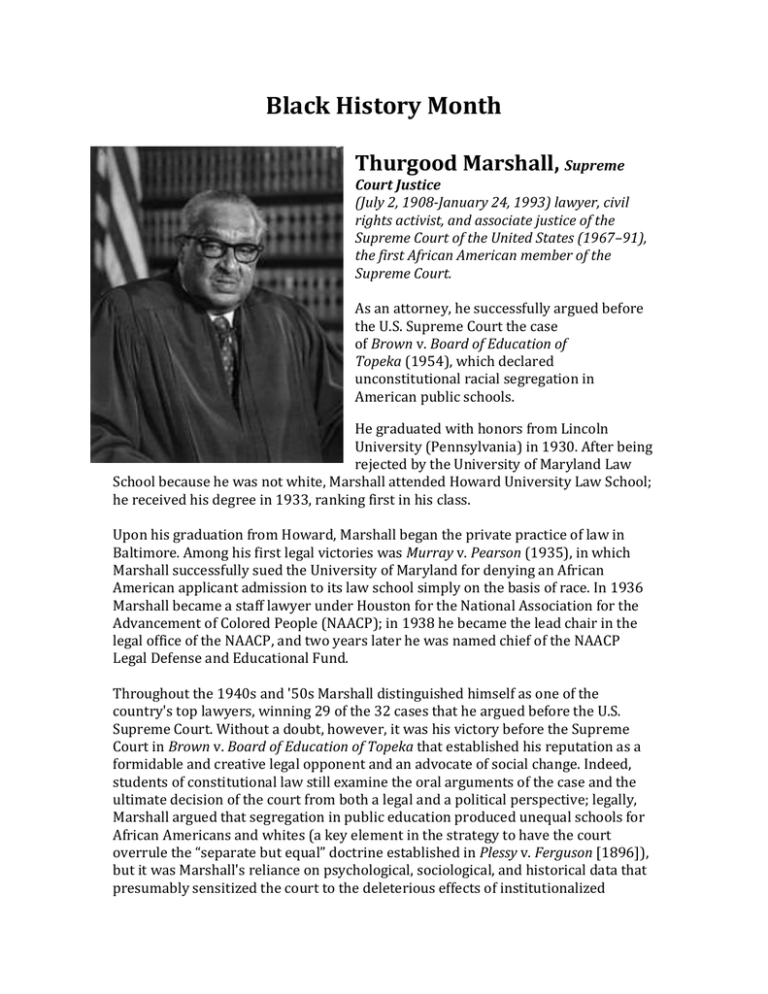
Black History Month
Thurgood Marshall, Supreme
Court Justice
(July 2, 1908-January 24, 1993) lawyer, civil
rights activist, and associate justice of the
Supreme Court of the United States (1967–91),
the first African American member of the
Supreme Court.
As an attorney, he successfully argued before
the U.S. Supreme Court the case
of Brown v. Board of Education of
Topeka (1954), which declared
unconstitutional racial segregation in
American public schools.
He graduated with honors from Lincoln
University (Pennsylvania) in 1930. After being
rejected by the University of Maryland Law
School because he was not white, Marshall attended Howard University Law School;
he received his degree in 1933, ranking first in his class.
Upon his graduation from Howard, Marshall began the private practice of law in
Baltimore. Among his first legal victories was Murray v. Pearson (1935), in which
Marshall successfully sued the University of Maryland for denying an African
American applicant admission to its law school simply on the basis of race. In 1936
Marshall became a staff lawyer under Houston for the National Association for the
Advancement of Colored People (NAACP); in 1938 he became the lead chair in the
legal office of the NAACP, and two years later he was named chief of the NAACP
Legal Defense and Educational Fund.
Throughout the 1940s and '50s Marshall distinguished himself as one of the
country's top lawyers, winning 29 of the 32 cases that he argued before the U.S.
Supreme Court. Without a doubt, however, it was his victory before the Supreme
Court in Brown v. Board of Education of Topeka that established his reputation as a
formidable and creative legal opponent and an advocate of social change. Indeed,
students of constitutional law still examine the oral arguments of the case and the
ultimate decision of the court from both a legal and a political perspective; legally,
Marshall argued that segregation in public education produced unequal schools for
African Americans and whites (a key element in the strategy to have the court
overrule the “separate but equal” doctrine established in Plessy v. Ferguson [1896]),
but it was Marshall's reliance on psychological, sociological, and historical data that
presumably sensitized the court to the deleterious effects of institutionalized
segregation on the self-image, social worth, and social progress of African American
children.
In September 1961 Marshall was nominated to the U.S. Court of Appeals for the
Second Circuit by President John F. Kennedy, but opposition from Southern senators
delayed his confirmation for several months. President Lyndon B. Johnson named
Marshall U.S. solicitor general in July 1965 and nominated him to the Supreme Court
on June 13, 1967; Marshall's appointment to the Supreme Court was confirmed by
the U.S. Senate on August 30, 1967.
Copyright © 1994-2011 Encyclopædia Britannica, Inc. For more information
visit Britannica.com
Richard and Mildred
Loving, Loving v. Virginia
Richard and Mildred became reluctant
activists in the Civil Rights movement
of the 1960s when they successfully
challenged Virginia's ban on
interracial marriage.
Barred from marrying in their home
state, the couple drove 90 miles north
to Washington, D.C. to tie the knot.
They'd been married just a few weeks,
living in Central Point, when in the
early morning hours of July 11, 1958,
the county sheriff, acting on an
anonymous tip that the Lovings were
in violation of the law, stormed into the couple's bedroom with a pair of deputies.
"Who is this woman you're sleeping with?" the sheriff asked the startled Richard
Loving. Mildred offered up the answer: "I'm his wife." When she pointed out the
couple's marriage certificate hanging on the wall, the sheriff coldly replied, "That's
no good here."
Richard ended up spending a night in jail, the pregnant Mildred several more, and
the couple eventually pleaded guilty to violating Virginia's Racial Integrity Act of
1924, which recognized citizens as "pure white" only if they could claim white
lineage all the way back to 1684. The Lovings' one-year sentences were suspended,
but the plea bargain came with a price: The couple was ordered to leave the state
and not return together for 25 years.
"Almighty God created the races white, white, black, yellow, malay and red, and he
placed them on separate continents," Judge Leon M. Bazile ruled. "And but for the
interference with his arrangement there would be no cause for such marriages. The
fact that he separated the races shows that he did not intend for the races to mix."
The Lovings followed orders. They paid their court fees; relocated to Washington,
D.C.; had three children; and only rarely made separate return visits to see friends
and family.
But by 1963, the Lovings decided they'd had enough. The Civil Rights movement
was blossoming into real change in America, and with a sense, perhaps, that this
new era might lead the Lovings back to their old life in Virginia, Mildred wrote
Attorney General Robert Kennedy to ask for his assistance.
Kennedy wrote back and referred the Lovings to the American Civil Liberties Union
(A.C.L.U.), which took on the couple as clients. The A.C.L.U.'s two lawyers for the
couple, Bernard S. Cohen and Philip J. Hirschkop, appealed the Lovings' case to the
Virginia Supreme Court of Appeals. For Richard Loving, the argument to be made
was a simple one: "Tell the court I love my wife, and it is just unfair that I can't live
with her in Virginia." When that court upheld the original ruling, the case went to
the United States Supreme Court.
On June 12, 1967, the high court agreed, unanimously coming down in favor of the
Lovings, striking down Virginia's law and allowing and the couple to return home. "I
feel free," Richard is reported to have said after the ruling.
There’s little doubt about Mildred and Richard's legacy. There's an unofficial holiday
celebrating their triumph and multiculturalism, called Loving Day (June 12). More
importantly, the prohibition against mixed race marriages has been stripped out of
every state constitution.
© 2012 A&E Television Networks. All rights reserved.
George Washington
Carver, Chemist and Inventor
An American agricultural chemist,
agronomist, and experimenter, his
development of new products derived
from peanuts (groundnuts), sweet
potatoes, and soybeans helped
revolutionize the agricultural economy
of the South.
Carver was the son of a slave woman owned by Moses Carver. During the Civil War,
slave owners found it difficult to hold slaves in the border state of Missouri, and
Moses Carver therefore sent his slaves, including the young child and his mother, to
Arkansas. After the war, Moses Carver learned that all his former slaves had
disappeared except for a child named George. Frail and sick, the motherless child
was returned to his former master's home and nursed back to health. Though the
Carvers told him he was no longer a slave, he remained on their plantation until he
was about 10 or 12 years old, when he left to acquire an education. He spent some
time wandering about, working with his hands and developing his keen interest in
plants and animals.
By both books and experience, George acquired a fragmentary education while
doing whatever work was available. In his late 20s he finished his high school
education in Minneapolis, Kan., while working as a farmhand. After a university in
Kansas refused to admit him because he was black, Carver matriculated at Simpson
College, Indianola, Iowa, where he studied piano and art, subsequently transferring
to Iowa State Agricultural College, where he received a bachelor's degree in
agricultural science in 1894 and a master of science degree in 1896.
Carver left Iowa for Alabama in the fall of 1896, and accepted a position as Director
of the newly organized department of agriculture at the Tuskegee Normal and
Industrial Institute. Carver devoted his time to research projects aimed at helping
Southern agriculture, demonstrating ways in which farmers could improve their
economic situation.
At this time agriculture in the Deep South was in serious trouble because the singlecrop cultivation of cotton had left the soil of many fields exhausted and worthless.
As a remedy, Carver urged Southern farmers to plant peanuts and soybeans, which
could restore the soil.
Carver found that Alabama's soils were particularly well-suited to growing peanuts
and sweet potatoes, but when the state's farmers began cultivating these crops
instead of cotton, they found little demand for them on the market. In response to
this problem, Carver set about enlarging the commercial possibilities of the peanut
and sweet potato. He ultimately developed 300 derivative products from peanuts—
among them cheese, milk, coffee, flour, ink, dyes, plastics, wood stains, soap,
linoleum, medicinal oils, and cosmetics—and 118 from sweet potatoes, including
flour, vinegar, molasses, rubber, ink, a synthetic rubber, and postage stamp glue.
In 1914, Carver revealed his experiments to the public, and increasing numbers of
the South's farmers began to turn to peanuts, sweet potatoes, and their products for
income. The South became a major new supplier of agricultural products.
When Carver arrived at Tuskegee in 1896, the peanut had not even been recognized
as a crop, but within the next half century it became one of the six leading crops
throughout the United States.
In 1940 Carver donated his life savings to the establishment of the Carver Research
Foundation at Tuskegee for continuing research in agriculture. During World War II
he worked to replace the textile dyes formerly imported from Europe, and in all he
produced dyes of 500 different shades.
Carver was uninterested in the role his image played in the racial politics of the
time. His great desire in later life was simply to serve humanity; and his work, which
began for the sake of the poorest of the black sharecroppers, paved the way for a
better life for the entire South. His efforts brought about a significant advance in
agricultural training in an era when agriculture was the largest single occupation of
Americans, and he extended Tuskegee's influence throughout the South by
encouraging improved farm methods, crop diversification, and soil conservation.
Copyright © 1994-2011 Encyclopædia Britannica, Inc. For more information
visit Britannica.com
W.E.B. Du Bois, Activist and
Writer
Du Bois graduated from Fisk University in
1888. He received a Ph.D. in history from
Harvard University in 1895.
Although Du Bois had originally believed that
social science could provide the knowledge to
solve the race problem, he gradually came to
the conclusion that in a climate of strong
racism, social change could be accomplished
only through agitation and protest.
Two years later, in 1905, Du Bois took the
lead in founding the Niagara Movement,
which was dedicated chiefly to attacking the platform of Booker T. Washington. The
small organization, which met annually until 1909, was significant as an ideological
forerunner and direct inspiration for the interracial NAACP (National Association for the
Advancement of Colored People), founded in 1909. Du Bois played a prominent part in
the creation of the NAACP and became the association's director of research and editor of
its magazine, The Crisis.
Du Bois' black nationalism took several forms—the most influential being his pioneering advocacy of PanAfricanism, the belief that all people of African descent had common interests and should work together in
the struggle for their freedom. Du Bois was a leader of the first Pan-African Conference in London in 1900
and the architect of four Pan-African Congresses held between 1919 and 1927.
He resigned from the editorship of The Crisis and the NAACP in 1934. Upon leaving the NAACP, he
returned to Atlanta University, where he devoted the next 10 years to teaching and scholarship. In 1940 he
founded the magazine Phylon, Atlanta University's “Review of Race and Culture.” In 1945 he published
the “Preparatory Volume” of a projected encyclopedia of the black, for which he had been appointed editor
in chief. He later returned to a research position at the NAACP. The Autobiography of W.E.B. Du Bois was
published in 1968.
Copyright © 1994-2011 Encyclopædia Britannica, Inc. For more information
visit Britannica.com
Ida B. Wells, journalist
Ida B. Wells was born a slave in 1862 in Holly
Springs, Mississippi. Her father, James, was a
carpenter and her mother, Elizabeth, was a
famous cook. Both parents were literate and
taught Ida how to read at a young age. She was
surrounded by political activists and grew up
with a sense of hope about the possibilities of
former slaves within the American society.
Both parents died, along with an infant
brother, during the 1878 yellow fever epidemic
when Ida was 16 years old. At that young age,
she assumed the responsibility of rearing her
five younger brothers and sisters.
She soon became a teacher in order to earn
money for the family and eventually ended up
working in Memphis. While there, one day
changed her life forever. She has accustomed to riding the train in whatever seat she
chose. In 1883, she sued the Chesapeake and Ohio Railroad because they forbade
her from sitting in the ladies coach subsequently wrote and article about the
experience. The success of her article about the ease influenced her career change to
journalist.
As injustices against former slaves raged throughout the South and a reign of terror
began, Wells' sense of indignation and quest for justice was fueled. She decided to
use her pen to expose the motives behind the violence. Lynching had become one of
the main tactics in the strategy to terrorize blacks, and exposing its real purpose
became the target of her crusade for justice. When three of her male friends, who
were upstanding, law-abiding, successful businessmen (in direct competition with
white businessmen), were lynched on the pretext of a crime they did not commit,
Wells wrote about the situation with a clarity and forcefulness that riveted the
attention of both blacks and whites. Her major contention that lynchings were a
systematic attempt to subordinate the black community was incendiary.
She advocated for both an economic boycott and a mass exodus. She traveled
through the United States and England, writing and speaking about lynching and the
government's refusal to intervene to stop it. This so enraged her enemies that they
burned her presses, and put a price on her head, threatening her life if she returned
to the South. She remained in exile for almost forty years.
Wells went to Chicago in the mid-1890s where she met and married Ferdinand
Barnett, a widower and a fellow crusader who was a well-known attorney as well as
the founder of The Conservator newspaper. In addition to raising Barnett's two
children from his previous marriage, the couple had four children of their own in
eight years. Even with this added responsibility, Wells continued in her relentless
fight for social justice. She was very active in the suffragist movement and became
one of the founding members of the National Association for the Advancement of
Colored People (NAACP) and the National Association for Colored Women (NACW).
Ida B. Wells-Barnett died in 1931, leaving a formidable legacy of undaunted courage
and tenacity in the fight against racism and sexism in America.
Source: www.idabwells.org
Maya Angelou, Author and Activist
Born Marguerite Johnson on April 4, 1928 in St.
Louis, Missouri. Angelou spent her difficult formative
years moving back and forth between her mother's
and grandmother's. At age eight, she was raped by
her mother's boyfriend, who was subsequently killed
by her uncles. The event caused the young girl to go
mute for nearly six years, and her teens and early
twenties were spent as a dancer, filled with isolation
and experimentation.
At 16 she gave birth to a son, Guy, after which she
toured Europe and Africa in the musical Porgy and
Bess. On returning to New York City in the 1960s, she
joined the Harlem Writers Guild and became
involved in black activism. She then spent several
years in Ghana as editor of African Review, where
she began to take her life, her activism and her
writing more seriously.
Maya Angelou's five-volume autobiography commenced with I Know Why the Caged
Bird Sings in 1970. The memoirs chronicle different eras of her life and were met
with critical and popular success. Later books include All God's Children Need
Traveling Shoes (1986) and My Painted House, My Friendly Chicken and Me(1994).
She has published several volumes of verse, including And Still I Rise (1987) and
Complete Collected Poems of Maya Angelou (1995). Her volume of poetry, Just Give
Me a Cool Drink of Water 'Fore I Die (1971), was nominated for the Pulitzer Prize.
In 1993, Angelou read 'On the Pulse of Morning' at Bill Clinton's Presidential
inauguration, a poem written at his request. It was only the second time a poet had
been asked to read at an inauguration, the first being Robert Frost at the
inauguration of John F. Kennedy. In 2006, Angelou agreed to host a weekly radio
show on XM Satellite Radio's Oprah & Friends channel. She also teaches at Wake
Forest University in North Carolina, where she has a lifetime position as the
Reynolds professor of American studies.
Drawing from her own life experiences, Angelou published Letter to My Daughter in
2008. She wrote the work for the daughter she never had, sharing anecdotes and
offering advice. Well received, the book earned several honors, including a NAACP
Image Award for Outstanding Literary Work-Non-Fiction.
© 2012 A&E Television Networks. All rights reserved.
Langston Hughes, Poet, Novelist,
Playwright, and Columnist
After publishing his first poem, "The Negro Speaks
of Rivers" (1921), he attended Columbia
University (1921), but left after one year to work
on a freighter, traveling to Africa, living in Paris
and Rome, and supporting himself with odd jobs.
After Vachel Linday promoted his poetry, he
attended Lincoln University (1925–9), and while
there he wrote his first book of poems, The Weary
Blues (1926), which launched his career as a
writer.
As one of the founders of the cultural movement known as the Harlem Renaissance,
he was innovative in his use of jazz rhythms and dialect to depict the life of urban
blacks in his poetry, stories, and plays.
“A Dream Deferred,” by Langston Hughes
What happens to a dream deferred?
Does it dry up
like a raisin in the sun?
Or fester like a sore-And then run?
Does it stink like rotten meat?
Or crust and sugar over-like a syrupy sweet?
Maybe it just sags
like a heavy load.
Or does it explode?
A prolific writer for four decades, he protested the injustices committed against his
fellow African Americans through his works. Among his most popular creations was
Jesse B Semple, better known as "Simple," a black Everyman featured in the
syndicated column he began in 1942 for the Chicago Defender.
© 2012 A&E Television Networks. All rights reserved.
Shirley Chrisholm, former
Congresswoman
Born Shirley St. Hill on November 30, 1924 in New
York City. Chisholm spent part of her childhood in
Barbados with her grandmother and graduated
from Brooklyn College in 1946.
She began her career as a teacher and earned a
Master's degree in elementary education from
Columbia University. She served as director of the
Hamilton-Madison Child Care Center from 1953 to
1959 as an educational consultant to New York
City's Bureau of Child Welfare from 1959 to 1964.
In 1969, Chisholm became the first black congresswoman and began the first of
seven terms. After initially being assigned to the House Forestry Committee, she
shocked many by demanding reassignment. She was placed on the Veterans' Affairs
Committee, eventually graduating to the Education and Labor Committee. She
became one of the founding members of the Congressional Black Caucus in 1969.
Chisholm became the first African American woman to make a bid to be President of
the United States when she ran for the Democratic nomination in 1972. A champion
of minority education and employment opportunities throughout her tenure in
Congress, Chisholm was also a vocal opponent of the draft.
After leaving Congress in 1983, she taught at Mount Holyoke College and was
popular on the lecture circuit. She is the author of two books, Unbought and
Unbossed (1970) and The Good Fight (1973).
© 2012 A&E Television Networks. All rights reserved.
Coretta Scott King, Activist
Born on April 27, 1927 in Marion, Alabama.
Although best known as the wife of 1960s civil
rights leader Martin Luther King, Jr., Coretta Scott
King established a distinguished career in
activism in her own right. Working side-by-side
with her husband throughout the 1950s and
1960s, King took part in the Montgomery Bus
Boycott of 1955 and worked to pass the 1964
Civil Rights Act. Her memoir, My Life with Martin
Luther King, Jr., was published n 1969.
Following her husband's assassination in 1968,
she continued their work, founding the Martin
Luther King, Jr. Center for Nonviolent Social Change in Atlanta, GA. She served as the
center's president and chief executive officer from its inception.
In 1980, a 23-acre site around King's birthplace was designated for use by the King
Center. The following year, a museum complex was dedicated on the site.
King also was behind the fifteen-year fight to have her husband's birthday instituted
as a national holiday — President Ronald Reagan finally signed the bill in 1983.
In 1995, King passed the reins of the King Center over to her son, Dexter, but she
remains in the public eye. She wrote regular articles on social issues and published a
syndicated column. She had been a regular commentator on CNN since 1980. In
1997, she called for a retrial for her husband's alleged assassin, James Earl Ray. Ray
died in prison before the trial could be effected.
Coretta and Martin Luther King, Jr. had four children: Martin Luther King III, who
now serves as president of the Southern Christian Leadership Conference (SCLC);
Yolanda, an actress; Bernice, a lawyer and Baptist minister; and Dexter; who runs
the King Library and Archive. King suffered a heart attack and stroke in August
2005; she died on January 30, 2006.
© 2012 A&E Television Networks. All rights reserved.
Malcolm X, Civil Rights Activist
Malcolm X was born as Malcolm Little
on May 19, 1925 in Omaha, Nebraska, to
Louise and Earl Little. When Malcolm
was four-years-old, his family moved to
East Lansing, MI.
Two years later, in 1931, Earl Little's
dead body was discovered laid out on
the municipal streetcar tracks. Although
Malcolm X's father was very likely
murdered by white supremacists, from
whom he had received frequent death
threats for his involvement in Civil
Rights Activism, the police officially
ruled his death a suicide, thereby
voiding the large life insurance policy he
had purchased in order to provide for
his family in the event of his death.
Malcolm X's mother never recovered
from the shock and grief of her
husband's death. In 1937, she was
committed to a mental institution and Malcolm X left home to live with family
friends.
In 1946, while living in Boston with his half-sister, Malcolm X was sentenced to ten
years in jail on charges of larceny. While in prison, he read extensively and began to
hear about the idea of Black Nationalism – the idea that in order to secure freedom,
justice and equality, black Americans needed to establish their own state entirely
separate from white Americans.
Supported largely by the Nation of Islam, a group his siblings had also recently
joined, Malcolm X converted to the Nation of Islam while in prison, and upon his
release in 1952 he abandoned his surname "Little," which he considered a relic of
slavery, in favor of the surname "X" – a tribute to the unknown name of his African
ancestors.
Now a free man, Malcolm X traveled to Detroit, where he worked with the leader of
the Nation of Islam, Elijah Muhammad, to expand the movement's following among
black Americans nationwide.
By the early 1960s, Malcolm X had emerged as a leading voice of a radicalized wing
of the civil rights movement, presenting an alternative to Dr. Martin Luther King's
vision of a racially integrated society achieved by peaceful means. Dr. King was
highly critical of what he viewed as Malcolm X's destructive demagoguery. "I feel
that Malcolm has done himself and our people a great disservice," he said.
In 1963, Malcolm X became deeply disillusioned when he learned that his hero and
mentor had violated many of his own teachings. Malcolm X left the Nation of Islam
in 1964.
That same year, Malcolm X embarked on an extended trip through North Africa and
the Middle East. The journey proved to be both a political and spiritual turning point
in his life. He learned to place the American civil rights movement within the context
of a global anti-colonial struggle, embracing socialism and pan-Africanism.
Malcolm X returned to the United States less angry and more optimistic about the
prospects for peaceful resolution to America's race problems. "The true
brotherhood I had seen had influenced me to recognize that anger can blind human
vision," he said. "America is the first country… that can actually have a bloodless
revolution." Tragically, just as Malcolm X appeared to be embarking on an
ideological transformation with the potential to dramatically alter the course of the
American civil rights movement, he was assassinated.
On the evening of February 21, 1965, at the Audubon Ballroom in Manhattan, where
Malcolm X was about to deliver a speech, three gunmen rushed the stage and shot
him 15 times at point blank range. Malcolm X was pronounced dead on arrival at
Columbia Presbyterian Hospital shortly thereafter. He was 39 years old. The three
men convicted of the assassination of Malcolm X were all members of the Nation of
Islam.
Source: www.biography.com
Charlayne HunterGault, Journalist , Radio
Personality, News Anchor
In 1961 Hunter became the first
African American woman to enroll
in the University of Georgia; she was
also among the first African
American women to graduate from
the university, earning a degree in
journalism in 1963.
After college, she moved to New
York City and worked for The New
Yorker magazine (1963–67) in an
administrative job and contributed
pieces to the “Talk of the Town” section. Many of her articles expressed rich and
realistic portrayals of life in Harlem.
She next joined The New York Times as a staff reporter (1968–77), eventually
becoming the newspaper's Harlem bureau chief. In addition to winning numerous
awards for her coverage of inner-city issues, Hunter-Gault brought about a
significant change in The Times's editorial policy, eventually convincing the editors
to drop their use of the word Negroes when referring to African Americans.
Hunter-Gault gained a national audience after she joined the Public Broadcasting
Service (PBS) news program MacNeil/Lehrer Reportin 1978. When the program
grew into the 60-minute MacNeil/Lehrer NewsHour in 1983, she became its national
correspondent and reported on topics that included racism, Vietnam veterans, life
under apartheid, drug abuse, and human rights issues. In 1997 Hunter-Gault left PBS
to become the Africa bureau chief for National Public Radio (NPR), and in 1999 she
was named Johannesburg bureau chief for the Cable News Network (CNN), a post
she held until 2005. She published a memoir, In My Place(1992), and New News Out
of Africa (2006), a book documenting positive developments in Africa. In 2005
Hunter-Gault was inducted into the National Association of Black Journalists (NABJ)
Hall of Fame.
Copyright © 1994-2011 Encyclopædia Britannica, Inc. For more information
visit Britannica.com

